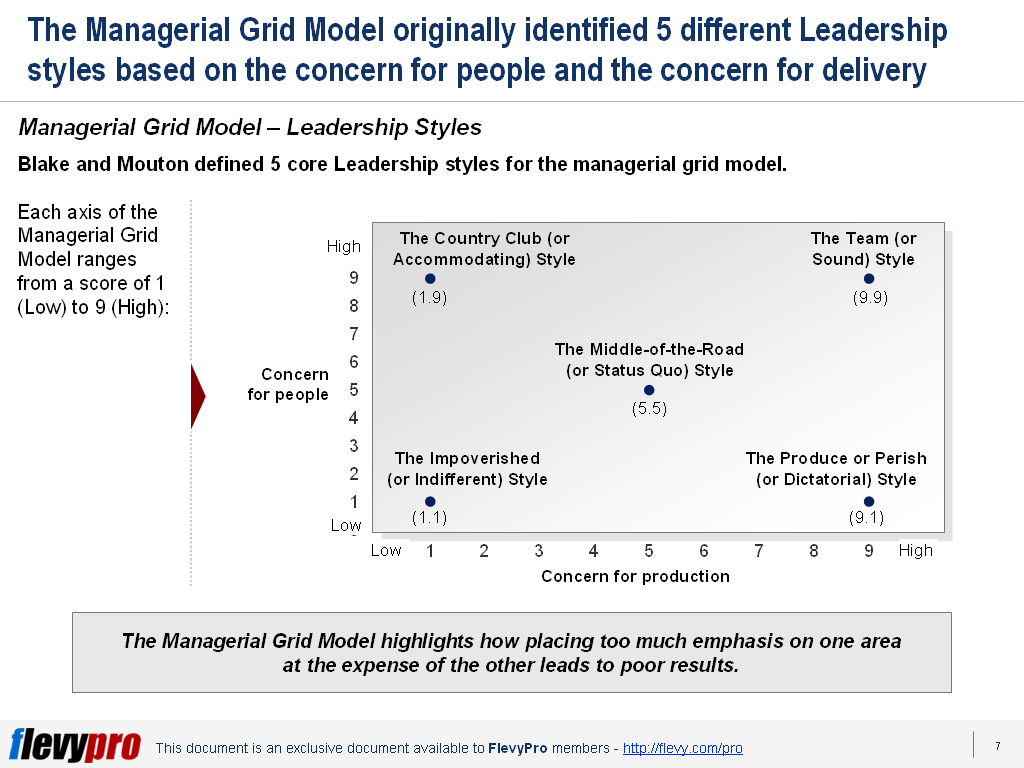Editor's Note: Take a look at our featured best practice, Leadership Competency Model (25-slide PowerPoint presentation). Behavioral competencies have long been utilized across many organizations to assess the competencies and potential of leaders. The competency models are prevalent due to several reasons--shared vocabulary to express the expectations from people, a basis for performance management planning, clarity [read more]
Also, if you are interested in becoming an expert on Organizational Leadership (OL), take a look at Flevy's Organizational Leadership (OL) Frameworks offering here. This is a curated collection of best practice frameworks based on the thought leadership of leading consulting firms, academics, and recognized subject matter experts. By learning and applying these concepts, you can you stay ahead of the curve. Full details here.
* * * *

One leadership style does not work in all situations. A variety of management and leadership styles exist for people in leadership roles, but each individual utilizes a unique style to get work done. Successful leaders need to understand the pros and cons of various leadership approaches, their impact on the people they command, and the anticipated results.
The Managerial Grid Model developed by Robert R. Blake and Jane Mouton, provides a method to understand the various leadership styles and how they work. The framework is useful for leaders to comprehend their innate management style, and develop skills that they are missing out on.
Leaders need to account for both tasks and people. The Managerial Grid, or Leadership Grid, is a useful framework to illustrate a leader’s concern for people or concern for results—the 2 dimensions of the model that exhibit an individual’s task versus person inclination. The model is represented as a grid that plots a leader’s degree of task-centeredness versus person-centeredness on the 4 quadrants of a grid—on X and Y axes. Each axis of the grid ranges from a score of 1 (Low) to 9 (High). The Blake-Mouton Managerial Grid suggests that when concern for both people and results is high employee engagement and productivity stands out.
The Managerial Grid identified 5 different leadership styles based on the concern for people and the concern for delivering results:
- The Impoverished (or Indifferent) Style
- The Country Club (or Accommodating) Style
- The Produce or Perish (or Dictatorial) Style
- The Middle-of-the-Road (or Status Quo) Style
- The Team (or Sound) Style

Over the years, the Managerial Grid Model has continued to evolve, and got updated with 2 additional leadership styles: Paternalistic Style and the Opportunistic Style.
Let’s, now, discuss the first 3 leadership styles further.
Impoverished Management Style
The impoverished managers have little concern for people and results, and they largely fail in both areas. The Impoverished manager is typically ineffective, is least interested in developing practices to get the task done and creating an encouraging team environment. Their work is often sub-optimal and does not meet the organizational requirements. Their team members do not get proper guidance required to accomplish their jobs appropriately, either. These managers use this style to keep the job and their seniority level, and strive to safeguard themselves by avoiding getting into trouble. Their sole concern is not to be held accountable for any mistakes. Consequently, their decisions making is sluggish and the culture lacks innovation and is marred with inefficiency, discontent, and conflict.
Country Club (or Accommodating) Management
The country club style of management has high value for people but low value for results. These managers are quite concerned about their team members’ needs and feelings. In hopes to improve productivity, they keep their teams happy and secure, which results in a fun work culture, but this doesn’t necessarily translate into a productive environment and often results in miserable outcomes owing to lack of direction and control. The top management is generally not satisfied by the performance of these managers, since their long-term results fall short of expectations.
Produce or Perish (or Dictatorial) Management Style
The dictatorial style of management has high value for results and low value for people. These managers put the needs of their team members secondary to results, and believe that employees are naturally unmotivated and dislike working. The authoritative leaders are autocratic, follow strict rules and procedures, and consider punishment a critical method to achieve organizational goals. This approach can drive impressive performance results in the near term, however, low team morale and motivation eventually knock over employee performance and leads to attrition and retention issues.
Interested in learning more about the 5 leadership styles, the behavioral dimensions, and 7 Key Managerial Behaviors? You can download an editable PowerPoint on the Managerial Grid Model here on the Flevy documents marketplace.
Are You a Management Consultant?
You can download this and hundreds of other consulting frameworks and consulting training guides from the FlevyPro library.

51-slide PowerPoint presentation
The objective of this module is to focus on some interpersonal skills so that you can enhance relationships with your clients and team members.
The first step toward becoming an effective consultant is to understand yourself. Learning to effectively work on teams is critical to how we work at
[read more]
Want to Achieve Excellence in Organizational Leadership (OL)?
Gain the knowledge and develop the expertise to become an expert in Organizational Leadership (OL). Our frameworks are based on the thought leadership of leading consulting firms, academics, and recognized subject matter experts. Click here for full details.
For both the current executives and leaders of tomorrow, our frameworks address 2 facets of Leadership:
1. How to elevate your management skills to becoming a Leader in your organization.
2. How to elevate your organization to becoming the Leader in your Industry.
Learn about our Organizational Leadership (OL) Best Practice Frameworks here.
Readers of This Article Are Interested in These Resources

27-slide PowerPoint presentation
Today's information-based, knowledge intensive, and service-driven economy has forced organizations to make substantial changes to the way they do business. With talented Human Capital now becoming the key strategic resource, the locus of the battle front has shifted. Managers not only have to
[read more]

166-slide PowerPoint presentation
This presentation is a compilation of PowerPoint descriptions and diagrams used to convey 23 different leadership models, philosophies and styles.
The Leadership Models/Philosophies/Styles include:
1. Carlyle & Galton Trait Theory
2. Ralph Stogdill Trait Theory
3. Kouzes & Posner
[read more]

164-slide PowerPoint presentation
While Lean principles are easy to understand, many implementations fall short. The challenge isn't the tools--it's the lack of a fundamental shift in daily management, which traditional leaders often overlook.
A core reason for failure is the absence of a Lean Daily Management System
[read more]

47-slide PowerPoint presentation
SlideKraft is pleased to present a workbook on the "9 Influencing Strategies Used By The Most Successful Leaders". This presentation covers the following strategies -
Empowerment
Interpersonal Awareness
Negotiation
Networking
Stakeholder Awareness
Shared Vision
Impact & Influence
[read more]






